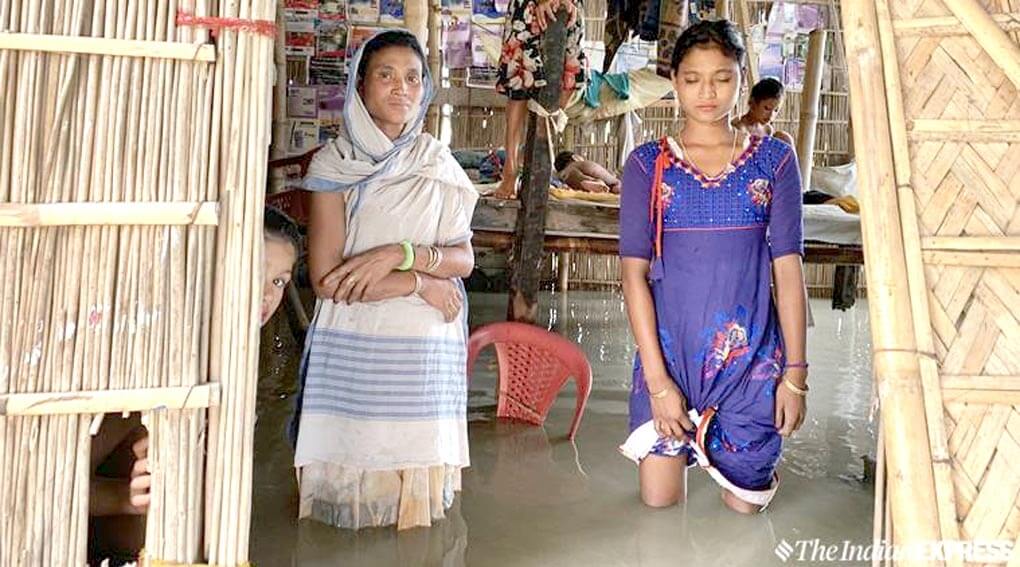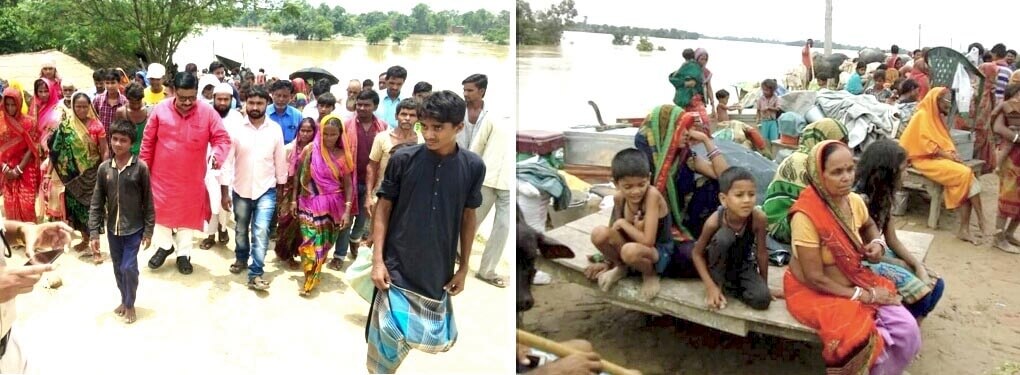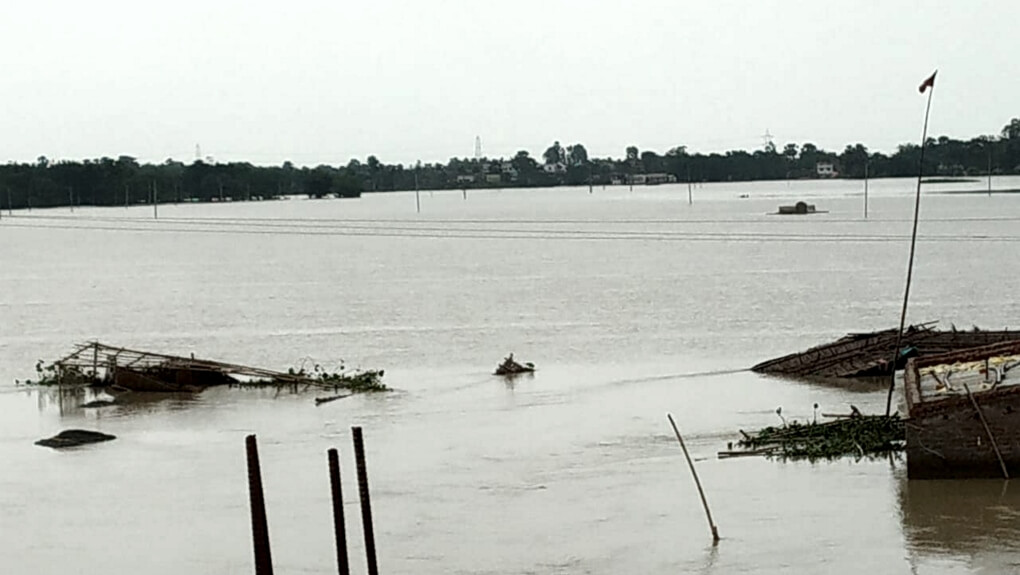
FLOODS are devastating vast areas of Assam and Bihar - as they tend to do every year. Heavy monsoon rains are a natural phenomenon, as are rivers swollen with monsoon rains or flooding their banks. But the loss of hundreds of lives and destruction of homes, livestock and lands is not “natural” or inevitable. This scale of devastation is preventable - and the total failure of governments to prevent it smacks of criminal callousness.
The Assam Deluge
In Assam, in the first wave of flood fury this monsoon, 57 lakh people are affected across all 33 districts, and 36 people have been killed as well as hundreds of animals, including livestock as well as wildlife. Two more waves at least are expected.
The mighty Brahmaputra river, which flows through Assam and floods every year, has a 580,000 sq km basin spreading across China, India, Bangladesh and Bhutan. The fact that it originates in cold and arid Tibet makes it carry a high level of sediment, which it discharges when it descends from the hills to Assam’s floodplains. It is this sediment that causes the flooding when the river channels become blocked.
While this sedimentation is indeed a natural phenomenon, it has become worse thanks in large part to manmade policies. Population growth in catchment areas not only in India but in China also is one factor.
Writing in Liberation in 2017 September, Sandipan Talukdar minted out:
The changing nature of the rivers is primarily attributable to the unscientific models of development and unscientific ways of managing the rivers. The huge construction projects undertaken in recent times like building the Dhola-Sadiya bridge, the Bogibeel bridge, the transnational highways in Arunachal Pradesh, Dibang dam, Siang dam and the most controversial lower Subansiri big dam. According to the data declared by Akhil Gogoi, the noted anti dam activist of Assam, in the construction of the Bogibeel bridge alone approximately 7.5 lakhs of boulders had been collected from the rivers both in Assam and Arunachal Pradesh. According to him the Dibang multipurpose project under construction in the lower Dibang valley of Arunachal Pradesh will require some 193 lakhs cubic meter of stones which equals to almost 32 lakh truckload of stones. Obviously this will be fulfilled by collecting boulders and big stones from the rivers both at hills and plains. A part of it could be met by stones from hills alone. Now geophysicists say that a huge boulder or stone contains silt or sand beneath it four times of its weight. When the boulders or stones are removed the silt and sands become exposed and when the water level rises they flow downstream. As a consequence the river gets filled up with silt first and thus grows to a height more than the banks. And the silt eventually gets deposited in all the areas the river floods. This has been the main cause of the silt-filled paddy fields in districts like Dhemaji and Lakhimpur of Upper Assam (North-eastern parts of Assam).

Destruction of wetlands and natural water bodies that act as natural run-offs have also been destroyed in the name of ‘development’ - compounding the problem.
Other solutions need to be explored. Retired Gauhati University professor Dulal Chandra Goswami, who is an environmentalist and expert on the Brahmaputra, told the Indian Express that “for a sustainable solution, there needs to be “a basin-wide approach” to the problem.” He says that we need an “integrated basin management” system that should involve all four basin-sharing countries: “Addressing the issues only in Assam when the flood strikes isn’t the solution — one needs the countries to come to an understanding about taking measures in the catchment areas.”
But such comprehensive flood management planning is missing in the approach of successive Governments.
Precautionary Measures Not Taken
The Government has failed to properly maintain embankments in Assam. The job of maintaining embankments is outsourced to contractors who are in a corrupt arrangement with Government officials.
Nor has the Government evolved any early warning mechanism, or any mechanism of early evacuation from flood-prone areas. Reportedly, villagers around the Assam-Bhutan border form WhatsApp groups to warn each other of rising water levels. Why can the Government not provide an effective early warning system if ordinary citizens can do it in a makeshift way?
The Central Government also unpardonably delayed the release of flood management funds to Assam.

Between The Floods And NRC
Reportedly, flood-affected people, especially from vulnerable minority communities, are reluctant to be evacuated to safety for fear that they may weaken their claim to being listed in the NRC (National Register of Citizens) if they do not have a home to show. Parvesh Kumar, a National Disaster Response Force worker, told the Indian Express that he had been trying to persuade Rina Begum, a resident of Tulsibari village in Assam’s Morigaon district of Assam, to leave her half-submerged house. But she refused, asking “How can we leave our home?” even as she stands in waist-deep water.
According to Indian Express, “In minority-dominated areas of Assam, home and land are tangible markers of identity in a state that is days away from the July 31 deadline for publication of the final National Register of Citizens (NRC). “This could be one of the reasons that they feel so scared to leave their homes,” says an official from the local administration.”
Another rescue worker Kailash Sharma told NDTV that a villager in Laharighat began “crying inconsolably” as he had left behind his NRC documents while being evacuated. “We sent our diver and he got the bunch of documents which was in the plastic pouch,” Sharma said.

CPIML Bihar MLAs Visit Flood-Affected Areas
CPIML MLAs in Bihar are visiting the flood devastated districts in the state while the party units all over are trying to mobilise volunteers as well as funds for the relief for the affected people. The party has also asked all state units for a fund collection drive for the same.
The floods in Bihar and Assam as well as in other flood prone states have become a perennial menace in face of zero mitigation measures and misappropriation of whatever meager funds got allocated for flood prevention. In spite of governmental assurances and promises made during last years’ floods people in the flooded regions are as helpless as before. So many lives have been lost and heavy economic devastation caused, they have been subjected to severe mental trauma which is a fallout of complete callousness of the government.
There will be floods with the onset of the monsoons is a known fact, sadly equally common is the reality that whenever floods come there has to be a breach in the embankments built for the flood prevention. The government in Bihar has no history of any punitive action taken against the officials for such criminal negligence.
CPIML Legislative group leader Mahboob Alam is at the moment in flood affected area of Katihar and Seemanchal region of the state. His own constituency Balrampur also falls in this region. Comrade Satyadev Ram is visiting flooded regions of Madhubani, Darbhanga and Samastipur districts; while Sudama Prasad has gone to Champaran, Muzaffarpur and Sitamarhi. Before leaving for these districts the CPIML MLAs placed an Adjournment motion inside the state Assembly, sadly the government did not allow even a discussion on that motion.

After first spell of rains in this monsoon season vast areas of Seemanchal, Mithilanchal and Sheohar and Champaran have been swept by the severe floods affecting millions of people. Most of the rivers are flowing above danger marks. People are dying in absence of any preparation on the part of the administration. There is no political will apparent in the government to give a permanent solution for this perennial problem, even a minimum preparation for the relief measures was not done for the floods which were anyway highly expected otherwise many lives and properties could have been easily saved. The state government in Bihar calls itself a double engine government as they claim to be backed by the BJP led government in the Centre, but so far whatever relief measures have been taken up by this twin-engine government are too less and too late.
The flood relief shelters provided are highly inadequate and people, along with their cattle, are forced to take shelters over the open embankments, highways and the rooftops. In many areas no relief has yet been provided by the state administration resulting in spontaneous sudden protests by the anguished masses at many places.
CPIML has demanded deployment of more NDRF and SDRF personnel in view of severity of the floods and lives being lost in absence of timely relief work.
Liberation Archive
- 2001-2010
-
2011-2020
- 2011
- 2012
- 2013
- 2014
- 2015
- 2016
- 2017
- 2018
-
2019
- JANUARY-2019
- FEBRUARY-2019
- MARCH-2019
- APRIL-2019
- May-2019
- LIBERATION, JUNE 2019
- Liberation JULY 2019
-
LIBERATION, August 2019
- August 15, 2019: Reclaim the Spirit of the Freedom Movement to Foil the Fascist Design of the Modi Government
- Stop Mob Lynching! Guarantee Justice for Tabrez!
- Modinomics 2.0 and Bahi-Khata 2019
- Protest against Railway Privatisation and Corporatisation
- Sovereign Foreign Debt: Is the Government Paving the Way for India's Bankruptcy?
- 'If People are Lynched for Not Saying Jai Shree Ram, I Will Certainly Protest'
- Delhi Factory Fires
- Sewer Deaths And The Robot Lie
- Wolf in Granny's Clothing: Exclusion Masquerades as Education
- Quality in School Education Cannot be Addressed Through Volunteerism
- Flood Havoc in Assam and Bihar
- Modi Regime Fans Islamophobia, Cracks Down On Rights
- In Solidarity With Miyah Poets
- Fresh Attacks On Universities -- DU Syllabus: Might Is Right
- An Open Letter From the Walls of JNU
- German Envoy Touches Feet Of Golwalkar's Statue At RSS HQ
- Draconian And Anti-Democratic Amendments To Laws
- Second Monthly London Vigil Against Fascism And Hindu Supremacy in India
- Sonbhadra: Adivasis Massacred With Police and Government Complicity
- Santosh Rana (1942-2019): Tireless Fighter For Dignity and Democracy for the Oppressed
- Red Salute To Comrade AK Roy
- Every Second ST, Every Third Dalit And Muslim In India Is Multi-Dimensionally Poor - Global MPI Index
- CPIML Appeal: Contribute to Flood Relief in Bihar and Assam
- Liberation, SEPTEMBER 2019
- Liberation, OCTOBER 2019
- Liberation, NOVEMBER 2019
- Liberation, DECEMBER 2019
- 2020
- 2021-2030
Charu Bhawan, U-90, Shakarpur, Delhi 110092
Phone: +91-11-42785864 | Fax:+91-11-42785864 | +91 9717274961
E-mail: info@cpiml.org







